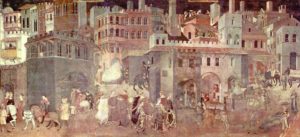The City Council was proud of its new building and wanted to make it a symbol that the citizens of the city would be proud of. They commissioned a local artist to do murals in the main chambers where the council held its meetings (see below). The murals would be reminders of what it would take for good government and a good city, as well as a warning about bad government and a bad city.
The murals would be there during council deliberations as a reminder when tough decisions were to be made. The artist was given total control over what the murals would depict.
The good government mural featured three essential traits of good government: justice, wisdom, harmony. Then there were the personifications of virtue: peace, bravery, prudence, modesty, mercy, faith, and hope. When council needed to decide on an action these traits and virtues became their guidance.
The good city mural had scenes of what is necessary for a city to thrive: commerce, construction, leisure, as well as green space for agriculture. Security was also featured.
The bad government/bad city mural contained images of flaws and bad practices. The flaws of bad government were projected as leadership which acted with traits of conceit, excessive frugality and excessive vanity. These traits were shown to manifest themselves as cruelty, betrayal, deception, wrath, disharmony, and tyranny.
The murals became a symbol for the city and created a culture for what it takes to have a flourishing community. When people visited the city, its citizens would often take them to see the murals. They became a source of pride.
The painter, Ambrogio Lorenzetti, considered the murals to be his masterpieces. It took over a year to produce them. They were completed in the city of Sienna, Italy from February 1338 to May 1339.
Just imagine if we had works of art in all seats of government today to serve as reminders of what good government is and how the actions of government leaders contributes to flourishing communities, states, and nations. Might these works of arts become a source of pride and an antidote to all the failures that citizens sense in their governmental leadership? This may stretch the imagination, but what worked close to seven centuries ago may still be effective today.
* * *
“Good government only happens when the people working in it do their jobs, and do them well.” – Matthew Lesko (entertainer)
